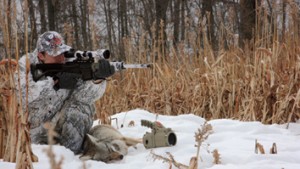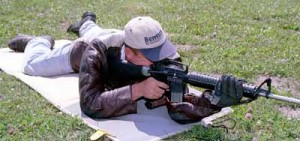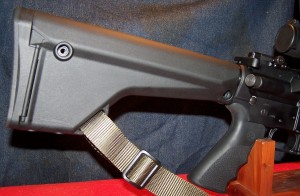Most “adjustable” stock are commonly referred to as “collapsible” stocks. I prefer “adjustable” because that is what we do with them – adjust them to the shooter. My bad for being technically incorrect?
Adjustable stocks are nice. They let the shooter adjust the rifle’s length of pull to fit their body and their shooting position quickly and rather quietly. But not everyone likes an adjustable stock — for some, the solid feel and rugged reliability of a fixed stock is superior. And then there are those unfortunate souls who live in places that don’t have things like freedom and can’t enjoy the pleasures of an adjustable stock. For them, a fixed stock is a requirement. But, is that a detriment?
There’s a huge difference between a good, solid fixed stock and a Adjustable stock in how a gun feels and handles. While the Adjustable stock has some advantages, they can feel a little flimsy. To me, I can never get a good solid shooting position. For precision shooting, a good solid shooting position is kind of important. That’s where the fixed stock comes in, giving the shooter a solid point of contact for the butt of the rifle and keeping wobble to a minimum. In the past, when fixed stocks reigned as king, adjustable stocks were to be found only on military-type weapons like the M1 Carbine. The M16 incorporated fixed stock on the A1 and A2 models. Rarely did you find them on “civilian” models of firearms, until the adjustable stock caught on. Today, most MSRs are fitted with adjustable stocks when manufactured and after-market manufactures have swarmed the market with adjustable stocks for virtually every long gun that is available to us.Adjustable stocks have an advantage over fixed stocks in that they adjust the overall length of the firearm as needed. For close-in work, the firearm may have to be held and tucked in close to the body, for example; during a house-clearing where the close quarters dictate the use of a compact-as-possible weapon. When medium-to-long distance work is called for, the operator may have to resort to the prone position, which places the face closer to the receiver; the stock can be extended to fit the situation.
Storage is another advantage of adjustable stocks over fixed stocks. An adjustable-stocked firearm simply takes less space to store over a fixed length stock firearm, which makes them a much better option for storing in and exiting from vehicles.
 Factoid! You may be running the MSR in different seasons. Clothing impacts LOP; clothing adds to or subtracts from LOP. The MSR that you ran during the summer in your T-shirt feels entirely different than when you ran the MSR in the winter while wearing three layers of clothing to keep your butt warm. This is where I do give an adjustable stock a point. An adjustable stock can be adjusted according to the type of clothing that you are wearing. With that said; however, I can do the same with a slip-on recoil pad on a fixed stock. Depending on the recoil pad, I can add or subtract ½” to 1” of LOP quickly or remove the recoil pad for a shorter LOP. Perhaps not as quick as with an adjustable stock, but quick enough for most situations.
Factoid! You may be running the MSR in different seasons. Clothing impacts LOP; clothing adds to or subtracts from LOP. The MSR that you ran during the summer in your T-shirt feels entirely different than when you ran the MSR in the winter while wearing three layers of clothing to keep your butt warm. This is where I do give an adjustable stock a point. An adjustable stock can be adjusted according to the type of clothing that you are wearing. With that said; however, I can do the same with a slip-on recoil pad on a fixed stock. Depending on the recoil pad, I can add or subtract ½” to 1” of LOP quickly or remove the recoil pad for a shorter LOP. Perhaps not as quick as with an adjustable stock, but quick enough for most situations.
For comparison purposes, consider the length of an adjustable stock to a fixed stock for the MSR: Colt M4: 10 1/4″ extended, A1: 9 5/8″, A2: 10 1/2″ to rear of lower.
Many manufactures are offering fixed stocks of various lengths to accommodate shooters of all sizes and body shapes. Butt pads can be changed out or slip-on recoil pads can offer a quick LOP adjustment (my usual fix for shorter-than-I-like LOPs).
“Battlefield Pickup” is a term that tactical-thinking types like to use – a lot. Would it not be convenient, while in a battlefield, to be able to pick up a rifle or carbine where I could adjust the stock to me very quickly? To tell you my truth – I don’t care! What I do care about, if I was in a battlefield and had to pick up a weapon, is that the weapon functions and shoots tiny projectiles downrange at high rates of speed, and I don’t care if it even has a stock! I’ll work with it. In my reality, a “battle field” pick-up will be one of the firearms that are strategically placed within my property – they belong to me and they all fit me. ‘Nuff said on that topic.Recently, I engaged myself in a project; swapping the adjustable stocks that came on the Windham Weaponry “SRC” and the Ruger AR 556 for fixed stocks, which are my personal preferences. I went through a couple of fixed stocks (A1 and A2 lengths) until deciding on which was the best for me.
I began the swap with an A2-length stock, which provided me with a 13 ½-inch LOP. I liked the LOP and I liked the stock, but I did not like the results of the build; it took too many o-rings to make the stock rattle free and that bothered me. I opted for a somewhat shorter stock, a MAGPUL MOE rifle-length stock that would eliminate the source of the rattle with the A2 stock – the spacer between the receiver extension and the butt plate. The difference in LOP was minimal, as the MAGPUL MOE stock is internally structured to compensate for the spacer. Thus, a rifle-length stock was able to mount using an A1 receiver extension. With both the Windham Weaponry “SRC” and the Ruger AR 556, the MAGPUL MOE fixed stock provides a rock solid platform. A Limbsaver slip-on recoil pad provides an additional 1” of LOP and works just fine, thank you. I can remove it for winter use when that time comes. Coupled with the use of ACU-wedges in both MSRs, they are as rock solid as can be expected and that equates to my having more confidence in the firearms in doing what I want them to do. The rest is up to me.The bottom line is to bring to the table what you are comfortable with; adjustable stock, fixed stock, folding stock, no matter. There is no advantage of one over the other until you make it so, and it is your opinion that matters to you.
![]()







